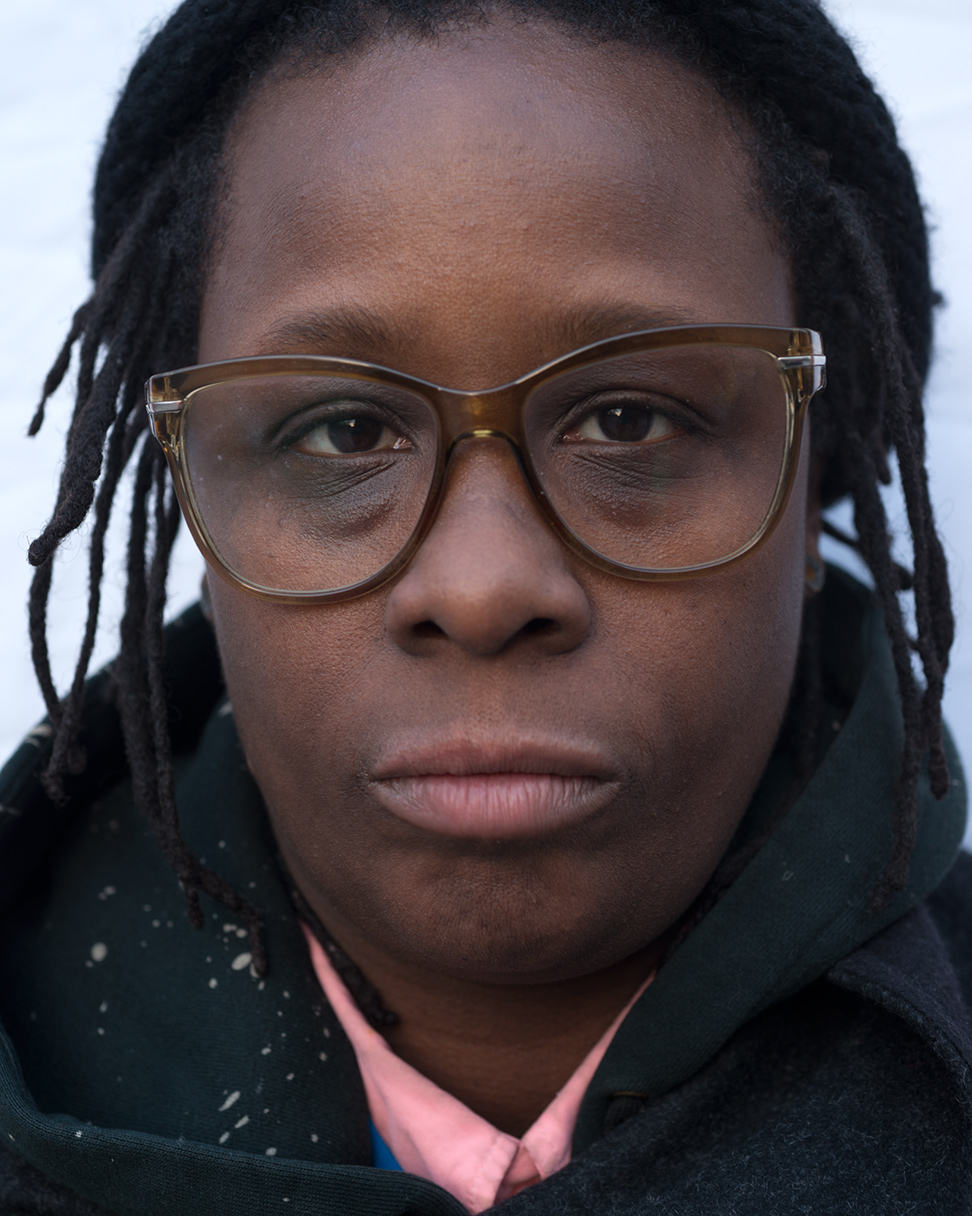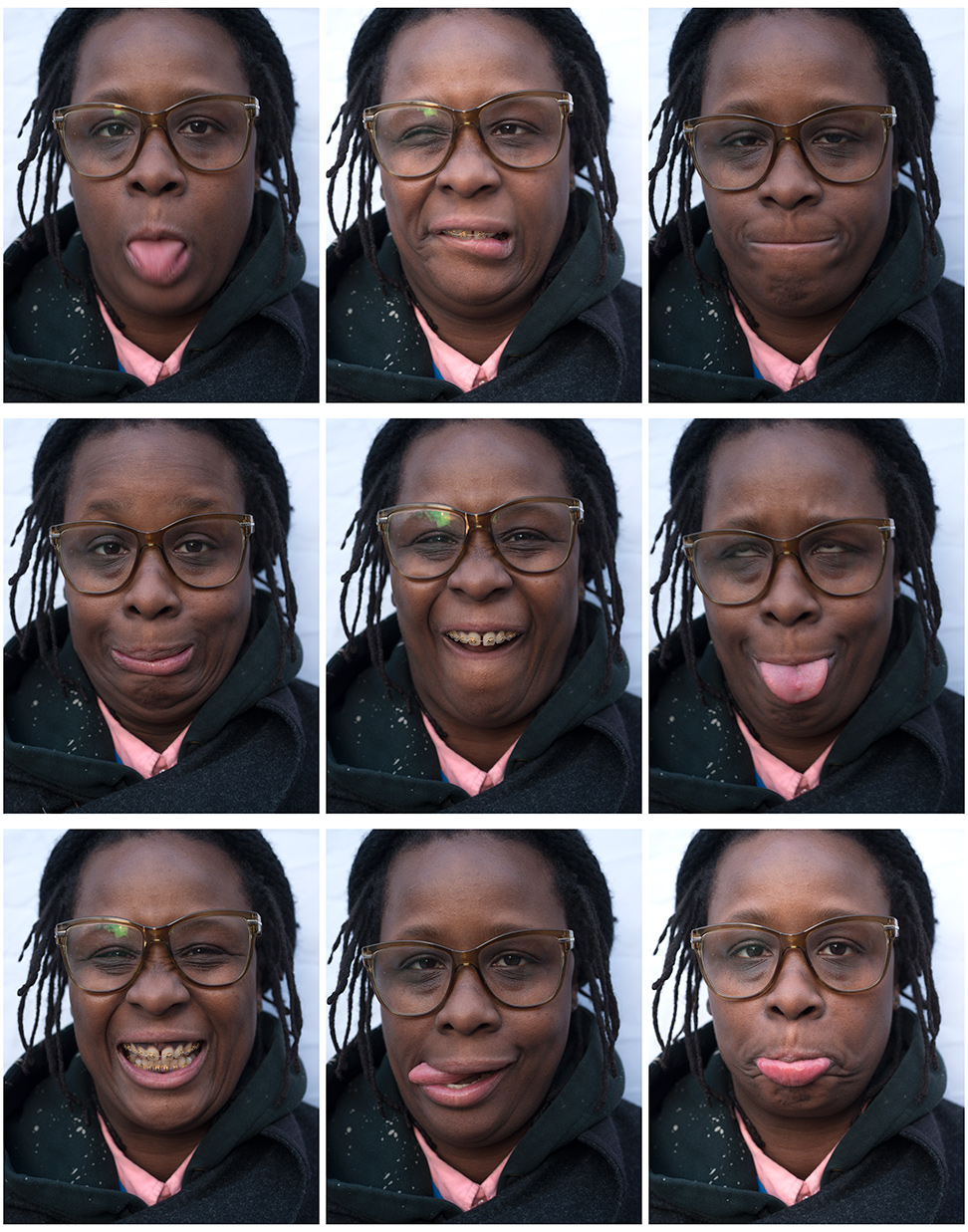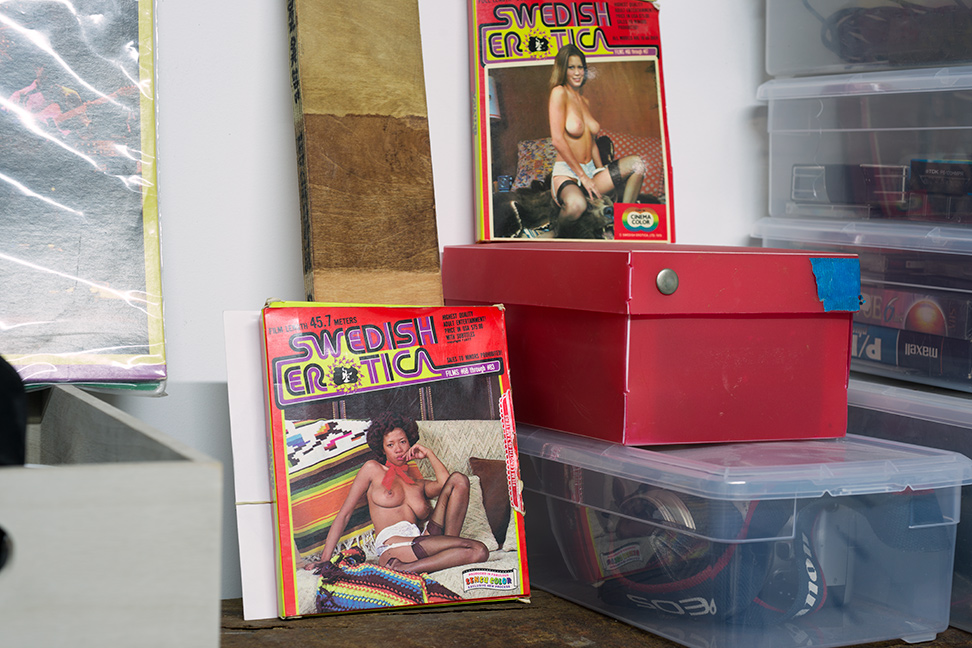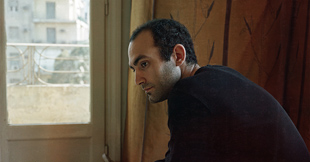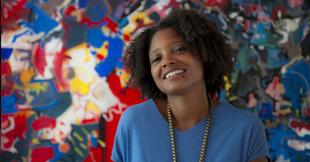
An interview by Carla Williams
Photographed by Christian Witkin
If you had never before heard of Mickalene Thomas, and were surfing around cable television looking for something quick to watch, and you stumbled upon her short film titled Happy Birthday to a Beautiful Woman on HBO, what would you make of this sweet, too-brief narrative of her mother’s youth? Would she seem familiar, like your own mom or auntie? Would the homage to a dying beauty transport you back to that glossy time in the 1970s when everything was a little more free? Would you shake your head in sympathy when she comes this close to joining the ranks of Beverly Johnson, Pat Cleveland, Iman, and all of those other trailblazing, gorgeous black women who once ruled the catwalks of Paris and Milan? Would the glimpses of glittering artworks interspersed with scenes of her illness-ravaged body compel you to linger, making inevitable comparisons? And would you be curious about the disembodied voice interviewing the Beautiful Woman, the daughter who only appears on camera in snapshots?
“My daughter, you have made me the model of the art world.”
In the past few years a handful of young women artists have chosen their mothers or grandmothers as their primary subjects, and in doing so, have transformed those relationships into more of an artistic collaboration than the usual artist/model dynamic. Multimedia artist Mickalene Thomas is among these collaborators; she began using her mother, Sandra Bush, as a frequent subject in her work nearly fifteen years ago. Although there is a fairly lengthy history of women artists who depict their children, or male artists who depict wives and lovers, this complex representational relationship is new territory, and Thomas has deftly surveyed it without any real precedent.
However, the end of their work together ultimately wasn’t the choice of either Thomas or Bush. “My mother’s passing [in 2012] wasn’t a shock,” Thomas says candidly. “We were very close and … it was a way for us to be with each other to make up for loss growing up, not spending time with each other. I encouraged her to take art classes, to open up her awareness about art. When I started making the film I thought, this is the last body of work I have on my mother; there’s not going to be anything else. I felt scared—my career is over. I won’t have her to pick up the phone, to bounce ideas off of when things are tough in the studio. She was the one who was always there to move forward.”
“That’s when I knew I would do anything for you.”
In work after work, Thomas depicts Bush as beautiful, sexual, desirable, stylish, fierce—and most importantly, as herself, not as anyone’s mother. “My mother allowed me to think about my work and not be rooted into a system,” the artist explains of the freedom that this collaboration afforded her. If you have ever tried to make a work of art of a close family member, you know how complicated that negotiation can be—you have a creative idea in mind, yet your subject knows exactly how she wants to be seen, and does not hesitate to let you know. Not many mothers—especially black mothers—will vamp it up for their daughters in leopard and lace à la Pam Grier.
Thomas clearly got her mother right—in her work, Bush is dressed up and dazzling, the surfaces of her painted images richly embellished with Thomas’ signature rhinestones.
Materials are important in Thomas’ work; in addition to rhinestones and sequins, many of her new works utilize oil pastel, silkscreen, and airbrushing. “We turned the studio into different areas of production—we do that all in-house,” she explains. “For me it’s important to get my hands on all these different materials.”
When Thomas first moved to New York in 2002, she worked as an intern at Christenrose Gallery. “Renée Cox was one of the first artists I met,” she recalls. Cox, who was represented by Christenrose, “was quite inspirational. She talked to me about what it was like to be an artist. I wanted to be an artist like her and looked at [her] photographs all the time. She was a beautiful, black woman who had this confidence and made no excuses to anyone for anything. That position was very intriguing to me. It wasn’t militant; it was very powerful and sexy and confident—especially those image of her with her son. She was a matriarch, owning and being accountable for herself.”
Like the artistic collaboration with her mother, Thomas’ early relationship with Cox was also significant in that here were two successful generations of creative black women in conversation with one another. These relationships between black women—whose numbers are relatively few in the competitive art world—are invaluable.
I ask Thomas about two other contemporary artists whose work I often discuss in context with hers, and she confirms just how small this circle is.
“Deana [Lawson] and LaToya [Ruby Frazier] are fantastic photographers. I think Deana worked with Renée. Carrie Mae Weems [whom Thomas also cites as a major influence] was LaToya’s teacher at Syracuse.”
In what is still a very young career, Thomas has already made an indelible mark on the art world, giving a breadth and complexity to a subject that is often maligned, frequently one-note, and much debated of late: black women. For someone who has studied the representation of black women for more than twenty years, Thomas’ work has been a sometimes uncomfortable, but more often indulgent, pleasure.
“Are you portraying an image that is stereotypically rooted in how the male gaze sees women?” Thomas asks rhetorically of her sensual, frankly sexual portraits of women often languidly posed with directness toward the camera. Her earlier body of work “was easier,” she says, because “I was using myself and my girlfriend, and I wasn’t asking someone to compromise. The more I looked at how they were perceived [the more I] I felt I was conforming to an idea I was against, so I had to rethink, and began looking at the female body in a different way, aligning it with iconic images.
“The position of any woman is at a crossroads and has been for some time with just how we want to be perceived in the world. We want to be taken seriously and recognized for our education, political positions, as mothers, sisters, women…but then there’s the other side—our sexuality. It’s just really confusing to young women. How far do you go? Is it too much? I want to claim a space, but be responsible with what I put out in the world. I want people to be inspired.”
The first time I saw her work in person, I tell her, I was almost literally drooling over its sumptuous colors and textures, which give it a presence impossible to reproduce. I’m reluctant to pull Thomas into a discussion that doesn’t foreground her real artistic mastery, yet race and sexuality are two very significant aspects of her work and to ignore them would be to act as though identity issues are no longer important; they still are. “I’m black, you can see. I don’t hide,” she says, “I don’t feel the need to say, ‘I’m a lesbian.’ I’m living my life, and [am] involved politically. I speak out. People can see who you are, but you don’t necessarily have to say. It was never in denial… I’m not that kind of person who’s going to preach, not that I’m passive. I’d rather have my voice be powerful and profound and courageous and reach an audience through my art. My voice is my art. I’m using my art to articulate and express all the aspects of who I am.”
“It would have been everything that I wanted…I would have been a great model.”
I didn’t stumble upon Happy Birthday on HBO—I knew Thomas’ work well, and I went looking for it. I had been unable to see it at the Brooklyn Museum, where visitors overflowed the small room in which it was shown, and I was thrilled that her work had reached a vast television audience. By the end of the film, it is evident that Thomas has become her mother’s dream for herself, not by becoming a high fashion model or even by landing a profile in Vogue—which she did in the April 2014 issue—but by embodying her creative spirit and living her own best life.
“My mother’s been such a support. I can go back and pull from her life an idea that fits into my own life through thinking about her. I was scared [of losing her, and] then I came back to my studio and thought about all of the other images I have that I haven’t used, and I realized that I have a new body of work. My work has opened up—it’s brighter, playful, more abstracted. I’ve been coming to my studio and making art as if I am a child, and it feels good. My daughter was born before my mother died; I started to see things differently. You become fully aware of time and space and what that really means. You cherish the people around you.
While the enticing prospect of another generation of creative women in this family may be premature, it will be exciting to watch how Thomas’ work develops when her muse is no longer her mother but perhaps her daughter, her inspiration not a rich life already lived but one in the process of formation. Either way, Thomas knows she’s in it for the long haul. “I will be making work until I die. I decided to be an artist. I invested in my career to be an artist,” she declares. “There’s going to be some response to it and it’s going to do its own thing. That’s the hope,” she says. “The audience does not dictate what I make in the studio, but I’m having a conversation with the world.” As her work expands and continues to challenge, inspire, and mesmerize, Thomas can be assured that her audience will ride with her wherever she elects to take us next.
